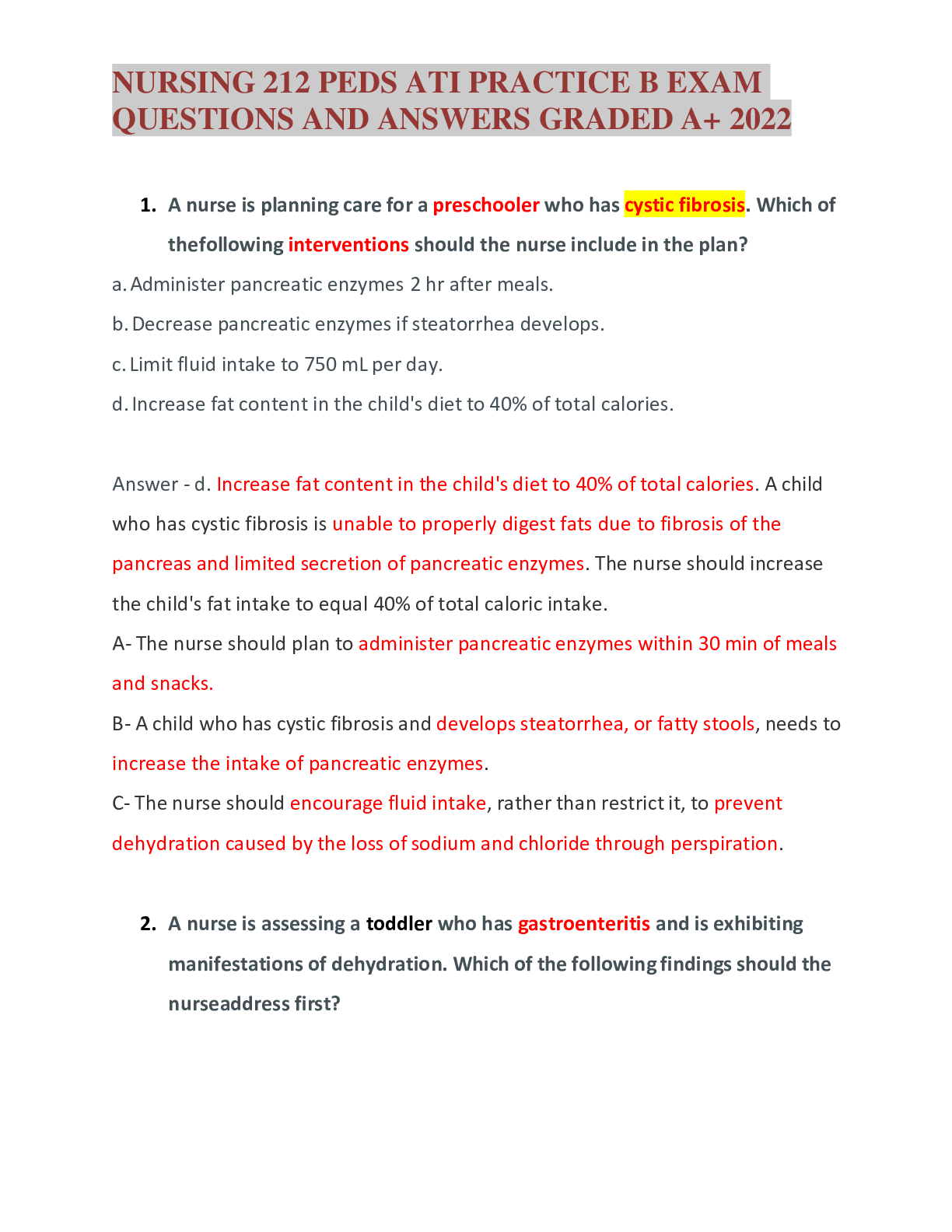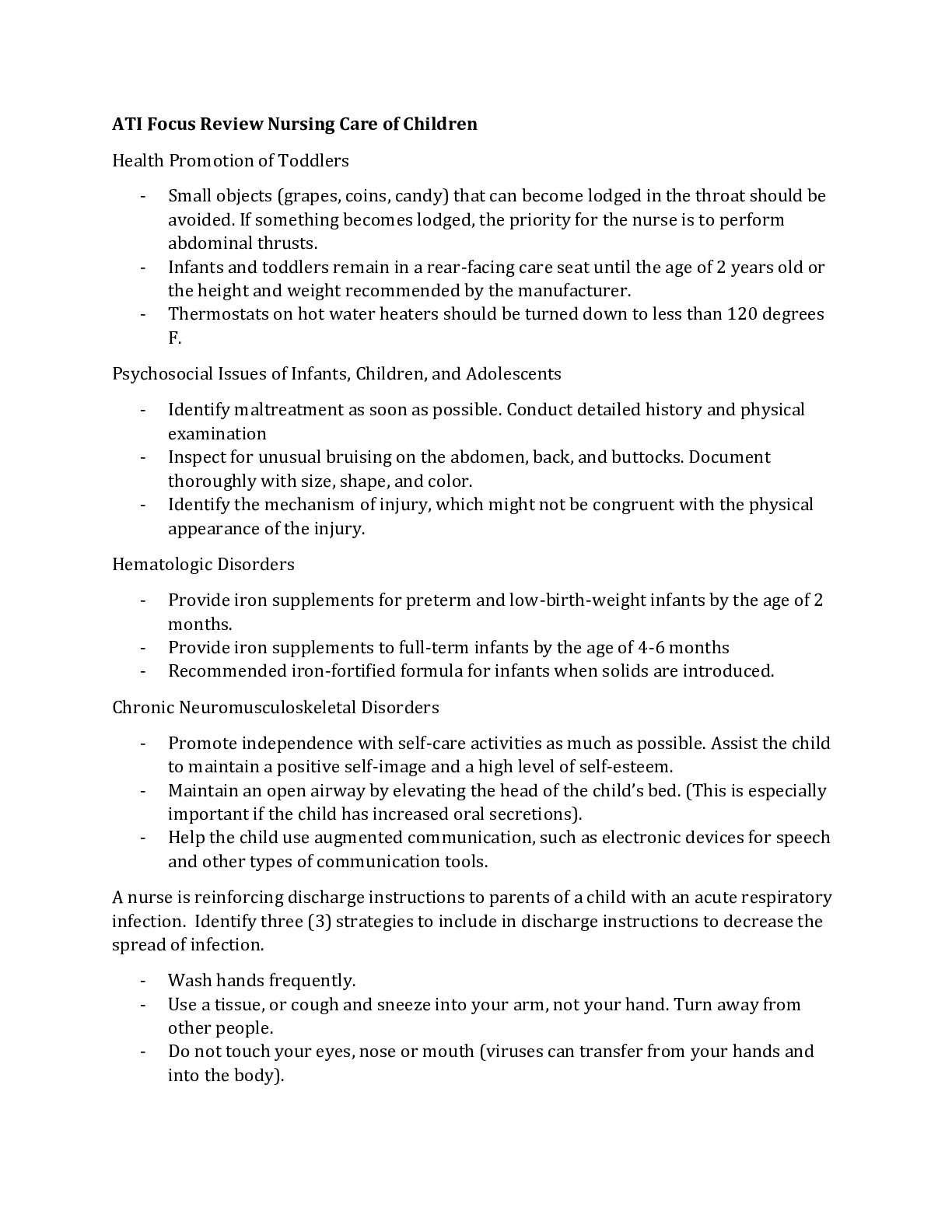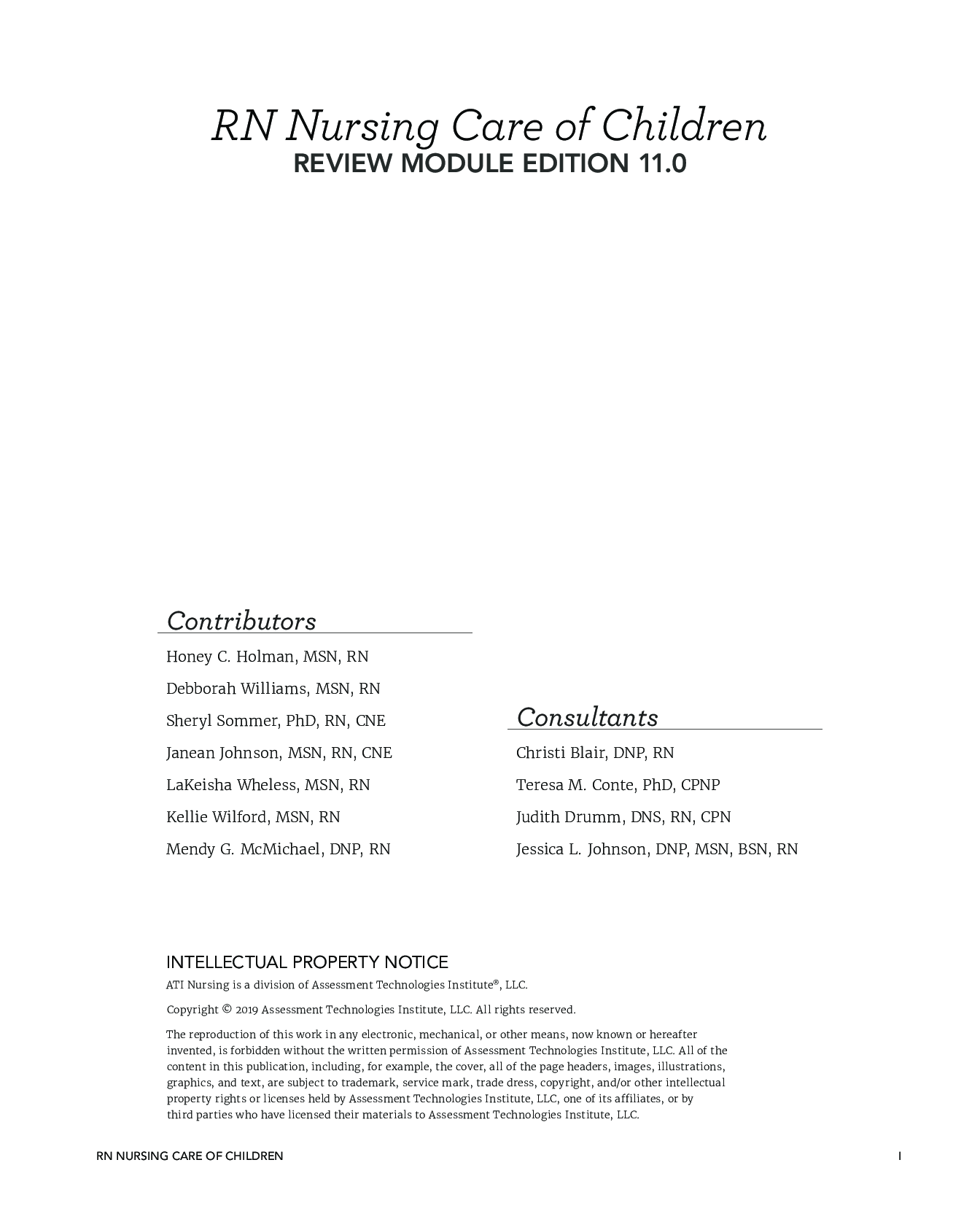*NURSING > QUESTIONS and ANSWERS > N212 ATI RN Nursing Care of Children Online Practice 2016 A | N 212 ATI RN Nursing Care of Children (All)
N212 ATI RN Nursing Care of Children Online Practice 2016 A | N 212 ATI RN Nursing Care of Children
Document Content and Description Below
N212 ATI RN Nursing Care of Children Online Practice 2016 A Teaching the parents of a school-aged child who has a new diagnosis of osteomyelitis of the tibia. The nurse should identify that which... of the following statements by the parents indicates an understanding of the teaching? my child will have a cast until healing is complete. My child will receive antibiotics for several weeks. My child can return to playing sports once he is discharged. My child needs to be in contact isolation. Answer: b The nurse should instruct the parent that the child will receive antibiotic therapy for at least 4 weeks. Surgery might be indicated if the antibiotics are not successful. A - incorrect Weight bearing must be avoided with osteomyelitis. Therefore, the child is placed in a comfortable position with the limb supported. There is no indication for a cast. C- incorrect Weight bearing should be avoided to prevent complications and minimize pain. Therefore, it will be several weeks to months before the child can play contact sports. D- incorrect Contact isolation is NOT necessary, because osteomyelitis is not a communicable illness. A nurse is auscultating the lungs of an adolescent who has asthma. The nurse should identify the sound as which of the following? Click the audio button to listen. A- Biots respiration B- Chaney Stokes respiration C- tackypnea D - Bradypnea Answer- c The nurse should identify the sound heard during auscultation as tachypnea, which is a rapid, regular breathing pattern. This breathing pattern often occurs with anxiety, fever, metabolic acidosis, or severe anemia. A- Biot's respirations are periods of apnea alternating with two or three shallow breaths. B- Cheyne-Stokes respirations are periods of apnea alternating with periods of hyperventilation. D- Bradypnea is a slow, regular breathing pattern. A nurse in an emergency department is caring for a school-age child who is experiencing an anaphylactic reaction. Which of the following is the priority action by the nurse? A- Elevate the head of the child's bed B- insert a large-bore IV catheter for the child C- determine the allergen that caused the child's reaction D- administer IM epinephrine to the child Answer- d When using the urgent vs nonurgent approach to client care, the nurse determines that the priority action is administering IM epinephrine to the child. During an anaphylactic reaction, histamine release causes bronchoconstriction and vasodilation. This is an emergency because ultimately it causes decreased blood return to the heart. A- Elevating the head of the child's bed is important to facilitate breathing and circulation. However, it is not the priority action the nurse should take. B- Inserting a large bore IV catheter is important to facilitate administration of IV fluids and medications. However, it is not the priority action the nurse should take. C- Determining the allergen that caused the child's reaction is important to prevent any additional episodes of anaphylaxis. However, it is not the priority action the nurse should take. The nurse is preparing to administer an immunization to a four-year-old child. Which of the following actions should the nurse plan to take? A- Place the child in a prone position for the immunization B- request that the child's caregiver leave the room during the immunization C- administer the immunization using a 24 gauge needle D- inject the immunization slowly after aspirating for 3 seconds Answer - c The nurse should administer an immunization for a 4-year-old child using a 24-gauge needle to minimize the amount of pain experienced by the toddler. A- The nurse should place the child in an upright sitting position for the immunization because this decreases the child's fear and anxiety. B- The nurse should allow the caregiver to stay near the child during the immunization to provide a sense of security and reduce the child's anxiety level. D- The nurse should inject the immunization rapidly and avoid aspiration. These actions decrease the risk of needle displacement and lower the child's fear and anxiety level by decreasing the amount of time it takes to administer the immunization. A nurse is reviewing the laboratory report of an infant who is receiving treatment for severe dehydration. The nurse should identify which of the following laboratory values indicates effectiveness of the current treatment? A- Potassium 2.9 mEq/L B- sodium 140 C- urine specific gravity 1.035 D- BUN 25 mg Answer- b The nurse should identify that a sodium level of 140 mEq/L is within the expected reference range and indicates the current treatment regimen the infant is receiving for dehydration is effective. A- A potassium level of 2.9 mEq/L is below the expected reference range and indicates hypokalemia. C- A urine specific gravity of 1.035 is above the expected reference range and indicates concentrated urine. D- A BUN level of 25 mg/dL is above the expected reference range and indicates the kidneys are not excreting BUN as they should be. The nurse is providing teaching about Social Development to the parents of a preschooler. Which of the following play activities should the nurse recommend for the child? A- Play pat-a-cake B- using a push pull toy C- creating a scrapbook D- playing dress-up Answer - d The nurse should instruct the parents that at the preschool age, play should focus on social, mental, and physical development. Therefore, playing dress-up is a recommended play activity for this child. A- Playing pat-a-cake is a recommended play activity for an infant. B- Using a push pull toy is a recommended play activity for a toddler. C- Creating a scrapbook is a recommended play activity for a school-age child. A nurse is teaching the parents of a newborn about ways to prevent sudden infant death syndrome SIDS. Which of the following instructions should the nurse include? A- Place the infant in a prone position to sleep. B- Allow the infant to sleep on a large pillow. C- User soft mattress in the infant's crib. D- Give the infant a pacifier at bedtime. Answer- d The nurse should inform the parent that protective factors against SIDS include breastfeeding and the use of a pacifier when the infant is sleeping. A- The nurse should instruct the parent to place the infant in a supine position to sleep. Prone and side-lying positions are risk factors for SIDS. B- Placing the infant on a large pillow to sleep can increase the risk of suffocation, asphyxiation, and SIDS. C- The nurse should instruct the parent to use a firm mattress and avoid the use of waterbeds, beanbags, or soft mattresses when placing the infant to bed. The use of a soft mattress in the infant's crib is a risk factor for SIDS and can lead to asphyxiation. A nurse is assessing an infant who has pneumonia. Which of the following findings is the priority for the nurse to report to the provider? A- Nasal flaring B- WBC 11,300 C- diarrhea D- abdominal distension Answer- a When using the airway, breathing, circulation approach to client care, the nurse should place the priority on nasal flaring. Nasal flaring indicates that the infant is experiencing acute respiratory distress. B- The nurse should report a WBC of 11,300/mm3 because it is above the expected reference range and indicates infection. However, another finding is the priority for the nurse to report. C- The nurse should report diarrhea because it is a manifestation of pneumonia in infants and indicates the current treatment is not effective. However, another finding is the priority for the nurse to report. D- The nurse should report abdominal distension because it is a manifestation of pneumonia in infants and indicates the current treatment is not effective. However, another finding is the priority for the nurse to report. A school nurse is assessing a school-age child blood pressure while he is seated in a chair. The child starts to experience a tonic-clonic seizure. Which of the following actions should the nurse take first? A- Clear the immediate area around the child of hazardous objects B- loosen the child restrictive clothing C- assist the child to a side-lying position on the floor D- apply an oxygen mask to the child Answer- c The greatest risk to this child is aspiration, occlusion of the airway, and bodily injury from falling out of the chair. The nurse should ease the child down to floor in a side-lying position immediately. This position enables the child's secretions to drain from the mouth, preventing aspiration, and maintaining a patent airway. A- The nurse should clear the area around the child of hazardous objects. However, this is not the first action the nurse should take. B- The nurse should loosen the child's restrictive clothing. However, this is not the first action the nurse should take. D- The nurse should apply an oxygen mask to the child to prevent hypoxia. However, this is not the first action the nurse should take. A nurse is preparing to administer ibuprofen 5 mg per kg every 6 hours PRN for temperatures above 38.0 degrees Celsius or 100.5 degrees Fahrenheit to an infant who weighs 17.6 lb. The infant has a temperature of 38.4 degrees Celsius or 100 + 1.2 degrees Fahrenheit. Available is ibuprofen liquid 100mg/ 5 ml. how many milliliters should the nurse administer to the infant per dose? Round the answer to the nearest whole number. Use a leading zero if it applies. Answer: 2 mL A nurse is receiving change-of-shift Report on for children. Which of the following children should the nurse assess first? A- A toddler who has a concussion and an episode of forceful vomiting B- an adolescent who has infective endocarditis and reports having a headache C- an adolescent who was placed into Halo traction 1 hour ago and rates his pain at a 6 on a 0-10 scale D- school-age child who has acute glomerulonephritis and brown colored urine Answer- a When using the urgent vs. nonurgent approach to client care, the nurse should assess this child first. An episode of forceful vomiting is an indication of increased intracranial pressure in a toddler who has a concussion. B- A report of a headache is nonurgent because it is an expected finding for a child who has infective endocarditis; therefore, the nurse should assess another child first. C- A report of moderate pain is nonurgent because it is an expected finding for a child who has a new halo traction device; therefore, the nurse should assess another child first. D- Brown-colored urine is nonurgent because it is an expected finding for a school-age child who has acute glomerulonephritis; therefore, the nurse should assess another child first. A nurse in the emergency department is caring for an adolescent who has severe abdominal pain due to appendicitis. Which of the following locations should the nurse identify as mcburney's point? Answer: a A is correct. The nurse should identify the lower right quadrant of the abdomen between the umbilicus and the anterior iliac crest as the location of McBurney's point. B is incorrect. The nurse should not identify the left lower quadrant as the location of McBurney's point. C is incorrect. The nurse should not identify the right upper quadrant as the location of McBurney's point. - - - - -- - - - - - - - - - - - - - - - - - - - - - - - - - - - - - - - - - - - - - - - - - - - - - - - -A nurse is creating a plan of care for a preschooler who has Wilms tumor and is scheduled for surgery. Which of the following interventions should the nurse include? A- Avoid palpating the abdomen when bathing the child before surgery B- refrain from auscultating the child bowel sounds during the post-operative assessment C- encourage the child to play with other children on the unit prior to surgery D- explain it to the child that his pain will be managed after the surgery Answer- a The nurse should avoid palpating the abdomen when bathing the child before surgery because movement of the tumor can cause cancer cells to disseminate to other sites, adjacent and distant to the tumor site. B- Auscultation of the child's bowel sounds to monitor for an obstruction is an important part of the postoperative assessment. Therefore, the nurse should auscultate bowel sounds following the surgery. C- The child's risk for injury increases with physical activity. Therefore, the nurse should not encourage the child to play with other children on the unit. D- Telling the child about pain prior to surgery will likely increase his fear and anxiety level. Therefore, the nurse should not explain to the child that pain will be managed after surgery. A charge nurse in an emergency department is preparing an in-service for a group of newly licensed nurses on the clinical manifestations of child maltreatment. Which of the following clinical manifestations should the charge nurse include as suggestive of potential physical abuse? A- Recurrent urinary tract infections B- symmetric Burns of the lower extremities C- growth failure D- lack of subcutaneous fat Answer- b The nurse should include in the teaching that symmetric burns of the lower extremities are a suggestive clinical manifestation of physical abuse. The patterns are usually characteristic of the method or object used, such as cigar or cigarette burns, or burns in the shape of an iron. A- Recurrent urinary tract infections are a suggestive clinical manifestation of sexual abuse. C- Growth failure is a suggestive clinical manifestation of physical neglect due to malnutrition. D- Lack of subcutaneous fat is a suggestive clinical manifestation of physical neglect. This manifestation is likely a result of poor healthcare, infections that were untreated, and/or a lack of or delayed childhood immunizations. The nurse is caring for a 15 year old client following a head injury. Which of the following findings should the nurse identify as an indication that the child is developing syndrome of inappropriate antidiuretic hormone secretion SIADH? A- sodium 148 B- urine specific gravity of 1.020 C- mental confusion D- weak peripheral pulses Answer- c A child who has a head injury can develop SIADH as a result of altered pituitary function, leading to an oversecretion of antidiuretic hormone. Oversecretion of antidiuretic hormone leads to a decrease in urine output, hyponatremia, and hypoosmolality due to overhydration. A- A sodium level of 148 mEq/L is above the expected reference range for a 15-year-old adolescent. SIADH is caused by the secretion of excess antidiuretic hormone, which results in a decreased serum sodium level due to increased circulation of free water. B- A urine specific gravity of 1.020 is within the expected reference range. A child who has SIADH is more likely to have concentrated urine and urine specific gravity above the expected reference range. D- A child who has SIADH is more likely to have fluid overload, full, bounding pulses, increased blood pressure, and tachycardia. A nurse in a provider's office is preparing to administer immunizations to a toddler during a well-child visit. Which of the following actions should the nurse plan to take? Prescriptions: tuberculin skin test TST measles mumps rubella vaccine inactivated influenza vaccine diphtheria, tetanus, and pertussis DTaP vaccine Vital signs respiratory rate 24/ minute heart rate 115/ minute temperature 37.4 degrees Celsius or 99.3 degrees Fahrenheit History and physical Age 12 months is 9 days height 71.1 CM or 28-in allergies neomycin - anaphylactic reaction caregiver reports rhinitis with clear nasal drainage for 2 days occasional non productive cough for 2 days history of asthma A- Withhold the measles mumps and rubella MMR vaccine B- withhold the DTaP vaccine C- withhold the influenza vaccine D- withhold the tuberculin skin test TST Answer- a The nurse should recognize that an allergy to neomycin with an anaphylactic reaction is a contraindication to receiving the MMR vaccine. Clients who have a severe allergy to eggs or gelatin should not receive this vaccine. B- It is safe to administer the DTaP vaccine at the same time as the MMR vaccine and TST. DTaP vaccines are not contraindicated in children who have mild acute illness or asthma. C- A child who has asthma can take the inactivated influenza vaccine. D- It is safe to perform a TST at the same time as administering MMR and varicella vaccines. A TST is not contraindicated in children who have mild acute illness or asthma. A nurse is caring for a preschooler who has been receiving IV fluids via a peripheral IV catheter. When preparing a to discontinue the IV fluids and catheter, which of the following actions should the nurse plan to take? Place the steps in order of performance. A- remove the tape securing the catheter B- turn off the IV pump C- occlude the IV tubing D- apply pressure over the catheter insertion site Answer- First, the nurse should turn off the IV pump. Next, the nurse should occlude the IV tubing, and then remove the tape securing the catheter. Last, the nurse should apply pressure over the catheter insertion site. A nurse is reviewing the dietary choices of an adolescent who has iron deficiency anemia. the nurse should identify that which of the following menu items has the highest amount of iron? A- ½ cup whole milk B- 1 cup orange juice C- ½ cup raisins D- one cup raw carrots Answer- c The nurse should encourage the adolescent to eat raisins because they contain the highest amount of nonheme iron. A- Whole milk does not contain the highest amount of iron. B- Orange juice does not contain the highest amount of iron. However, it does contain ascorbic acid, which increases the amount of nonheme iron absorbed by the body. D- Raw carrots do not contain the highest amount of iron. A nurse is creating an educational plan to teach parents about protecting their children from sun burns. Which of the following instructions should the nurse plan to include? A- Choose a waterproof sunscreen with an SPF of at least 15 B- apply sunscreen liberally to infants over three months of age C- dress children in a loose weave polyester fabric prior to sun exposure D- reapply sunscreen every 4 hours Answer- a The nurse should instruct parents to apply a waterproof sunscreen with an SPF of at least 15 for children. The parents should apply the sunscreen prior to sun exposure to reduce the risk of sunburn. B- The nurse should instruct parents to avoid the liberal application of sunscreen on infants under the age of 6 months. Parents should only apply sunscreen on infants under 6 months to small areas of exposed skin and should take other measures to reduce or prevent sun exposure. C- The nurse should instruct parents to dress their children in a tight weave cotton fabric prior to sun exposure to protect the skin. D- The nurse should instruct parents to reapply sunscreen every 2 to 3 hr. [Show More]
Last updated: 1 year ago
Preview 1 out of 40 pages
Instant download
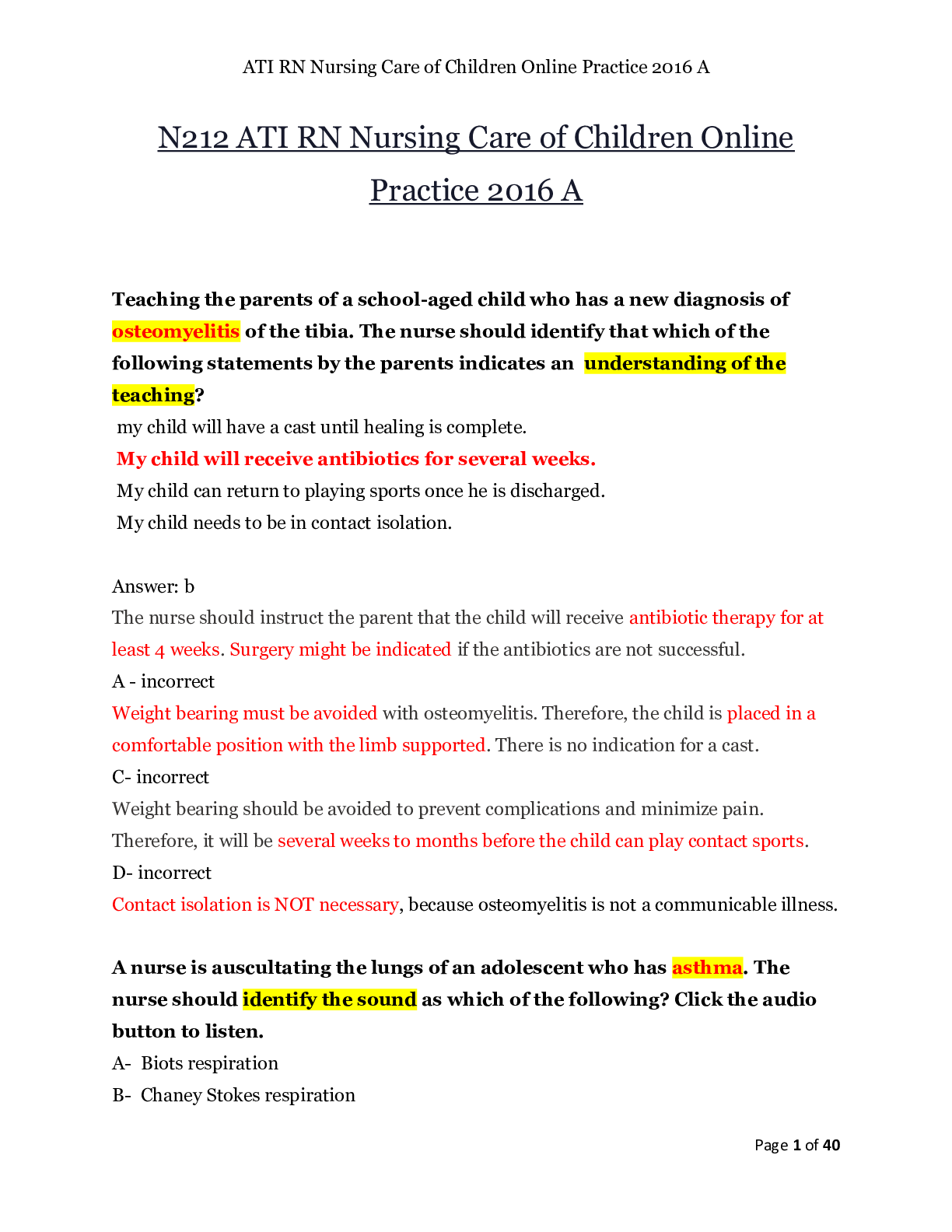
Buy this document to get the full access instantly
Instant Download Access after purchase
Add to cartInstant download
Reviews( 0 )
Document information
Connected school, study & course
About the document
Uploaded On
Jan 26, 2021
Number of pages
40
Written in
Additional information
This document has been written for:
Uploaded
Jan 26, 2021
Downloads
0
Views
37

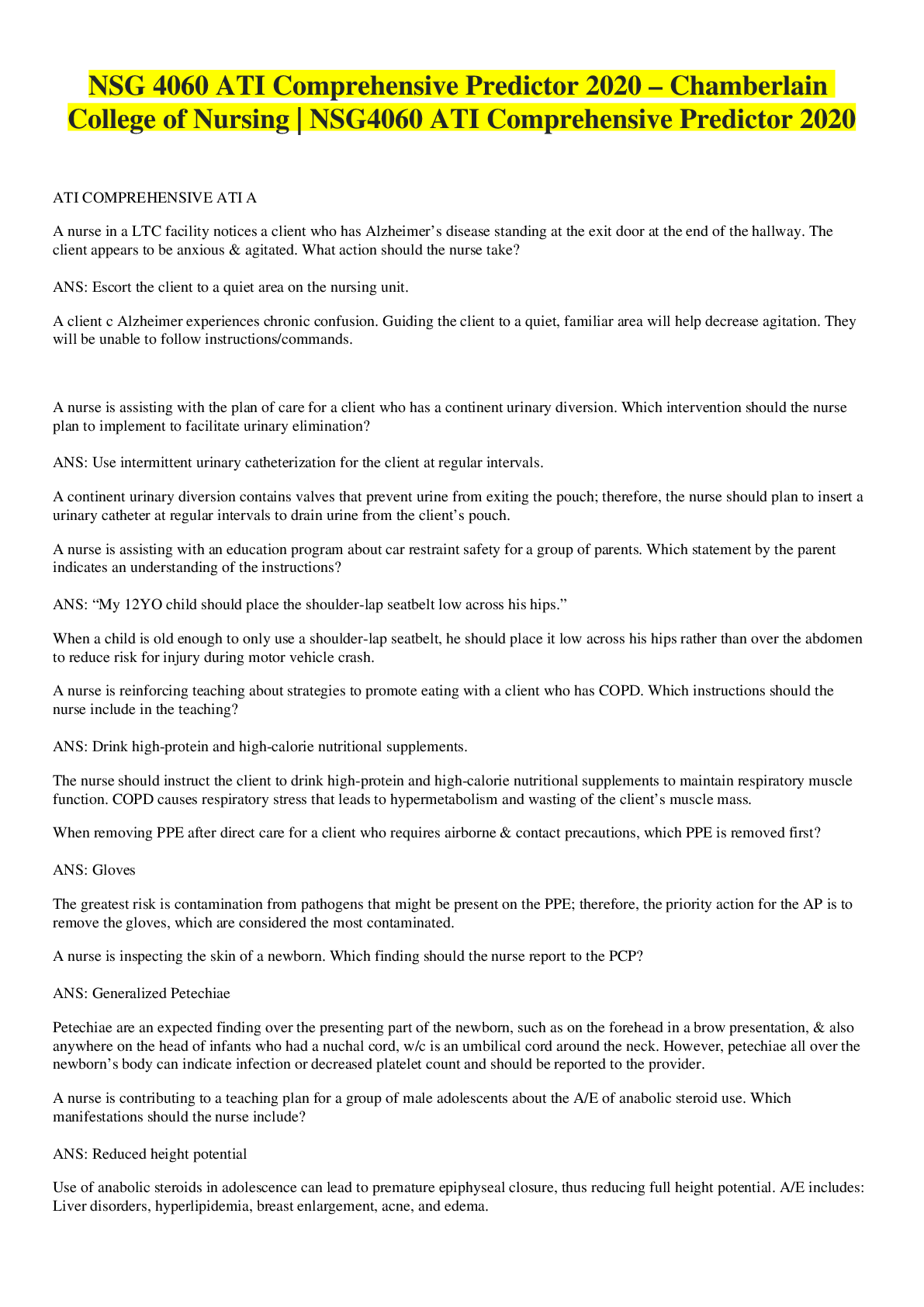


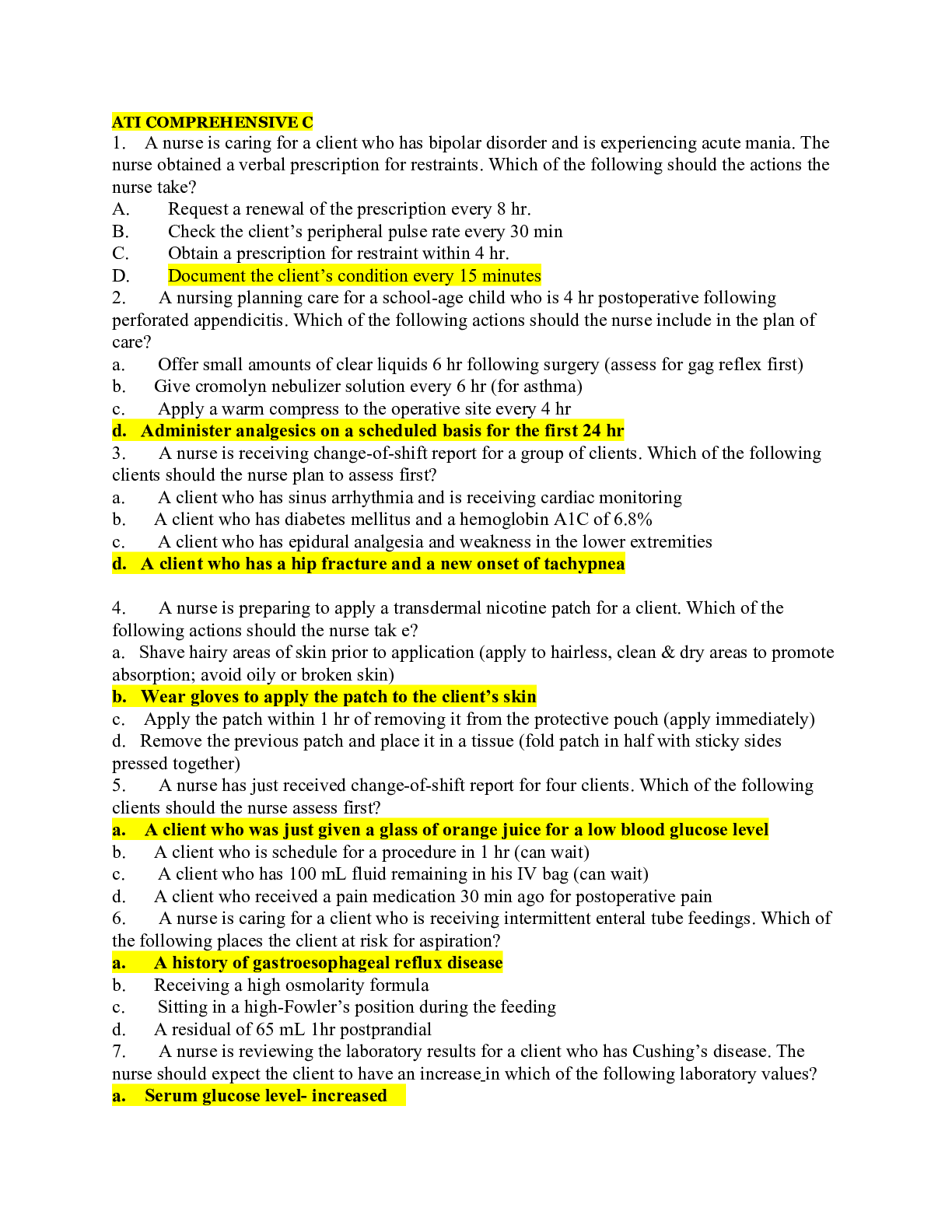
 – Concorde career College.png)
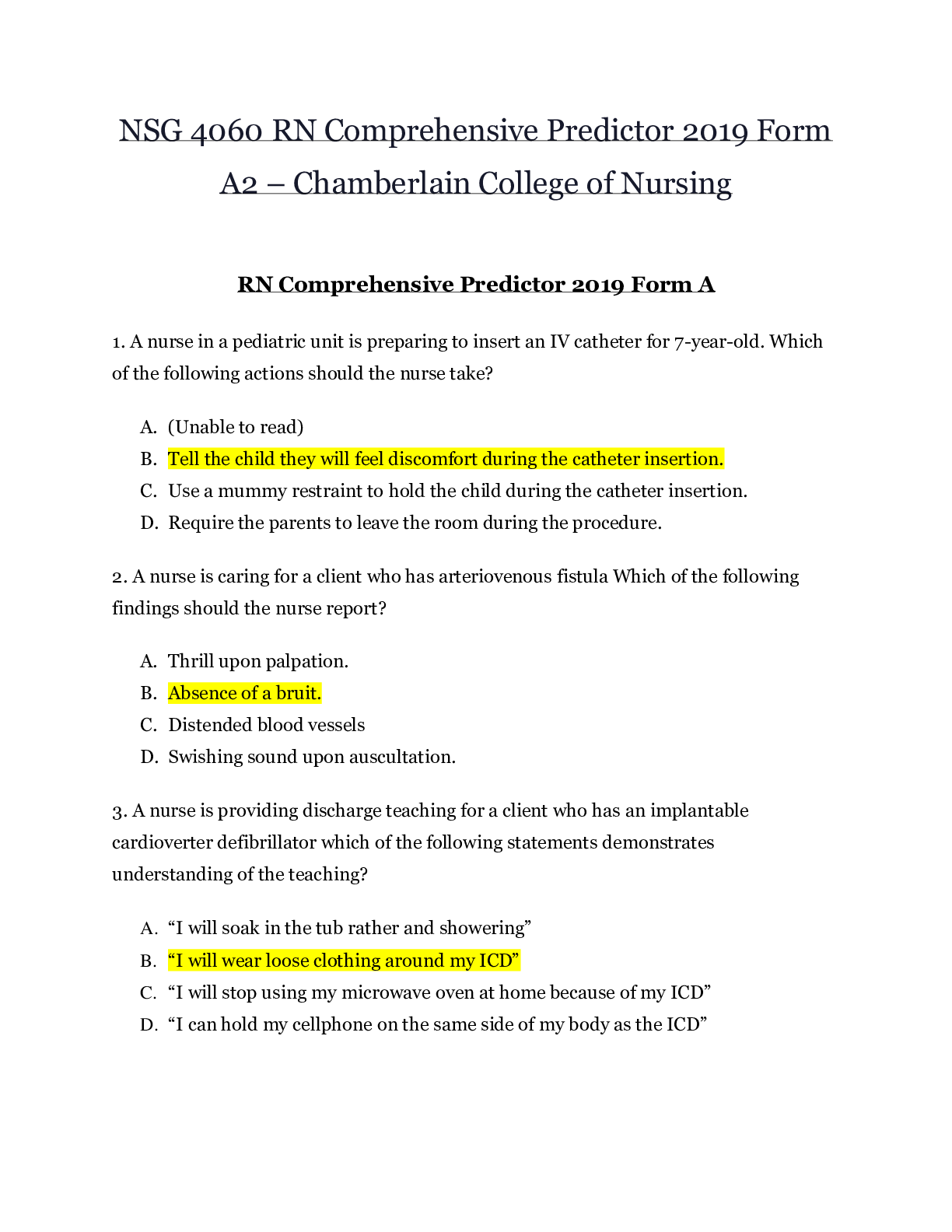
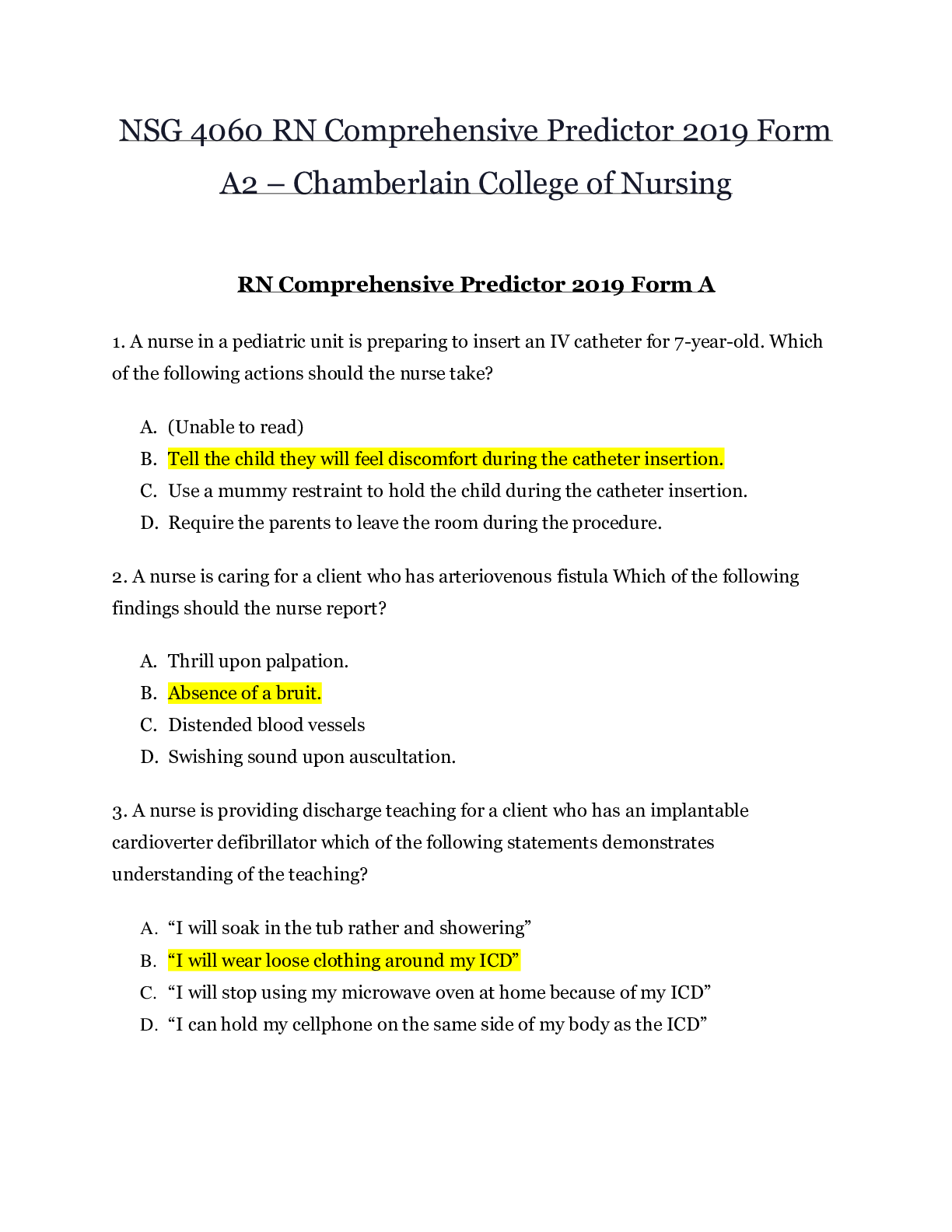

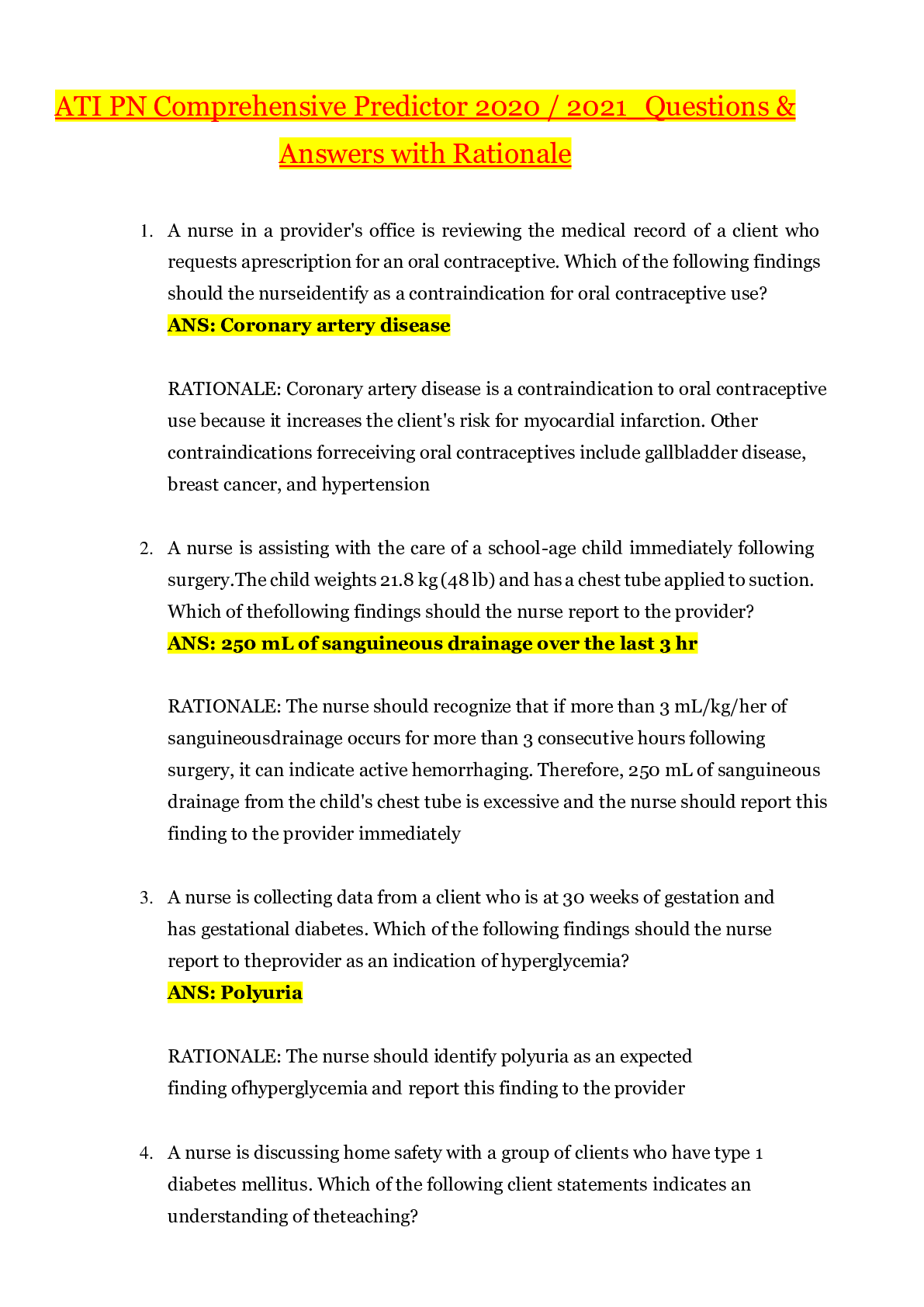
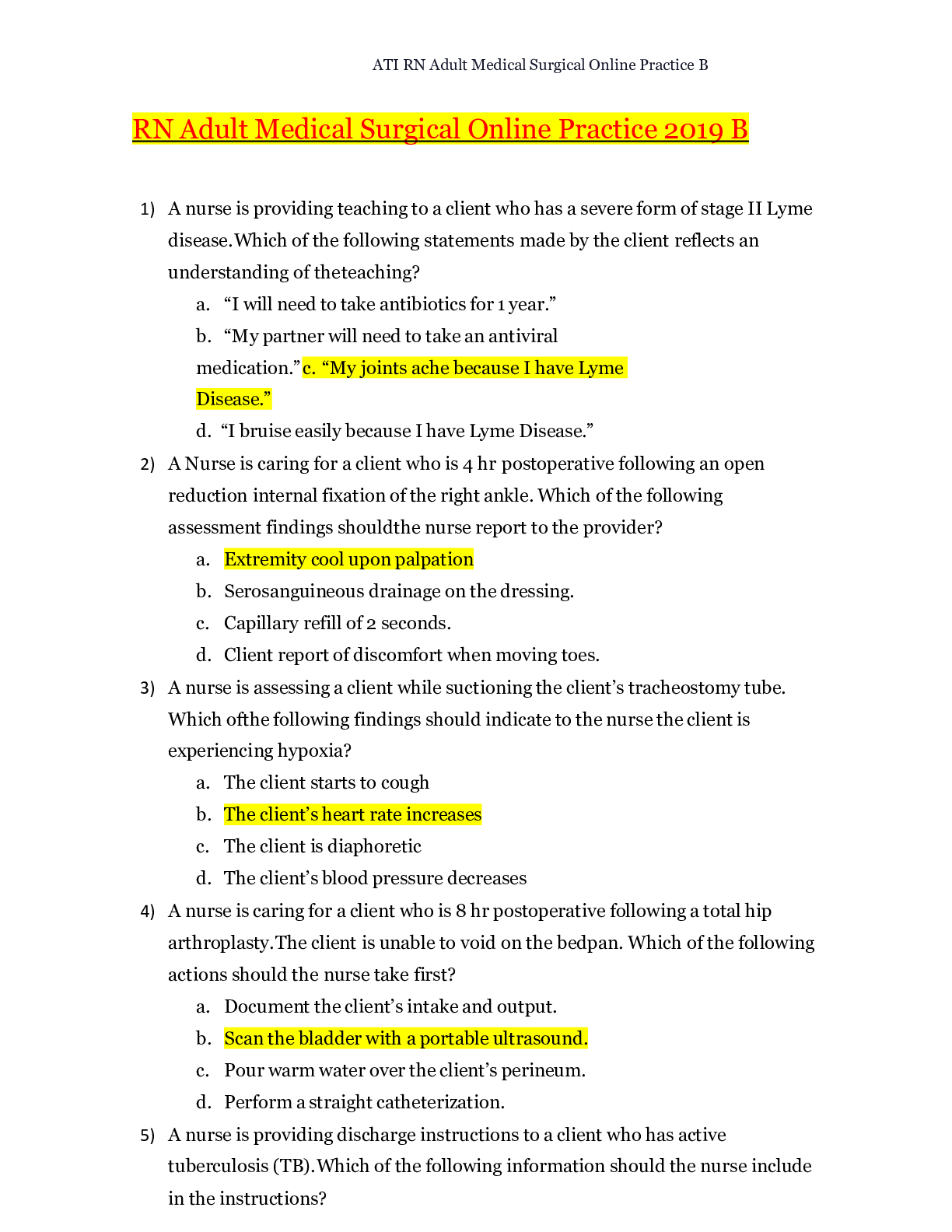
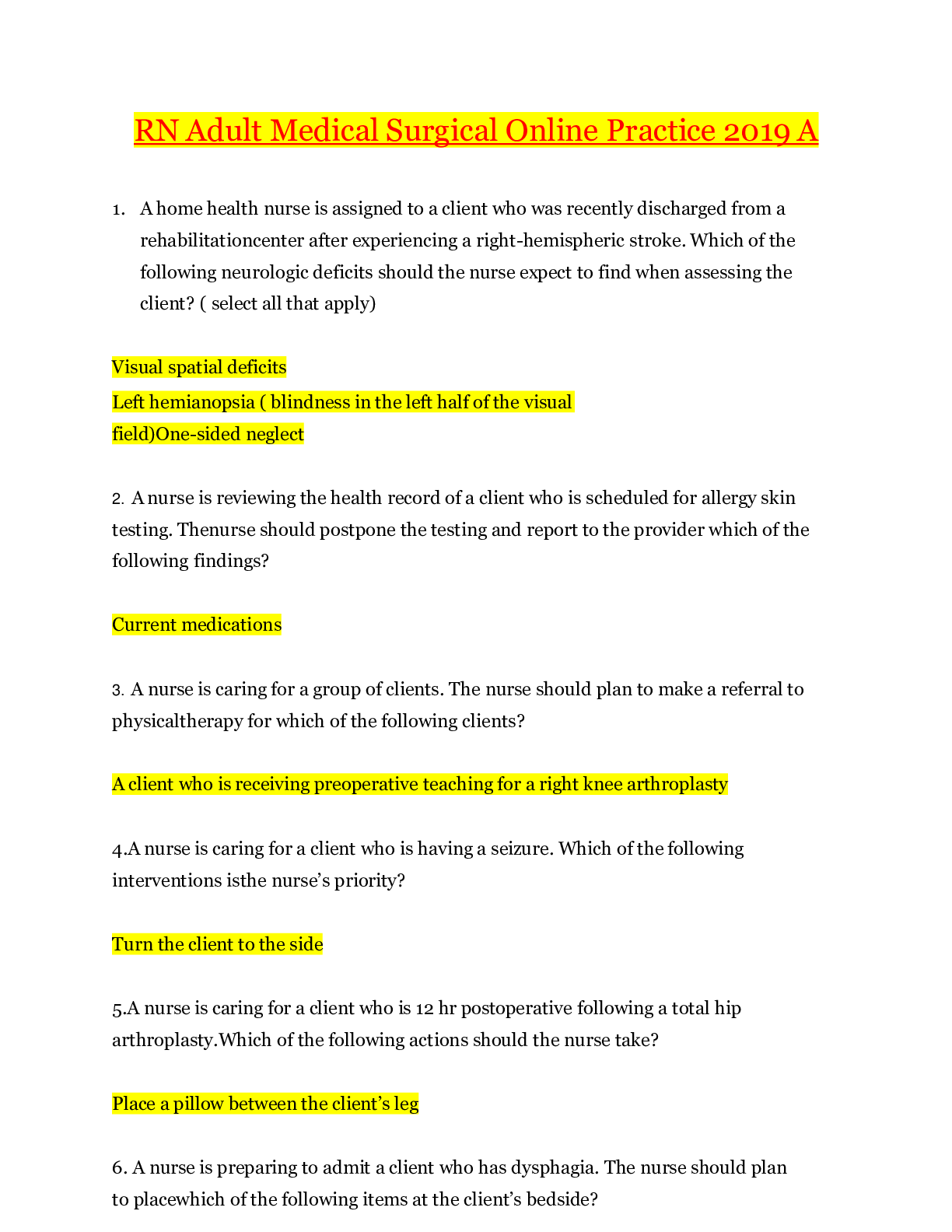
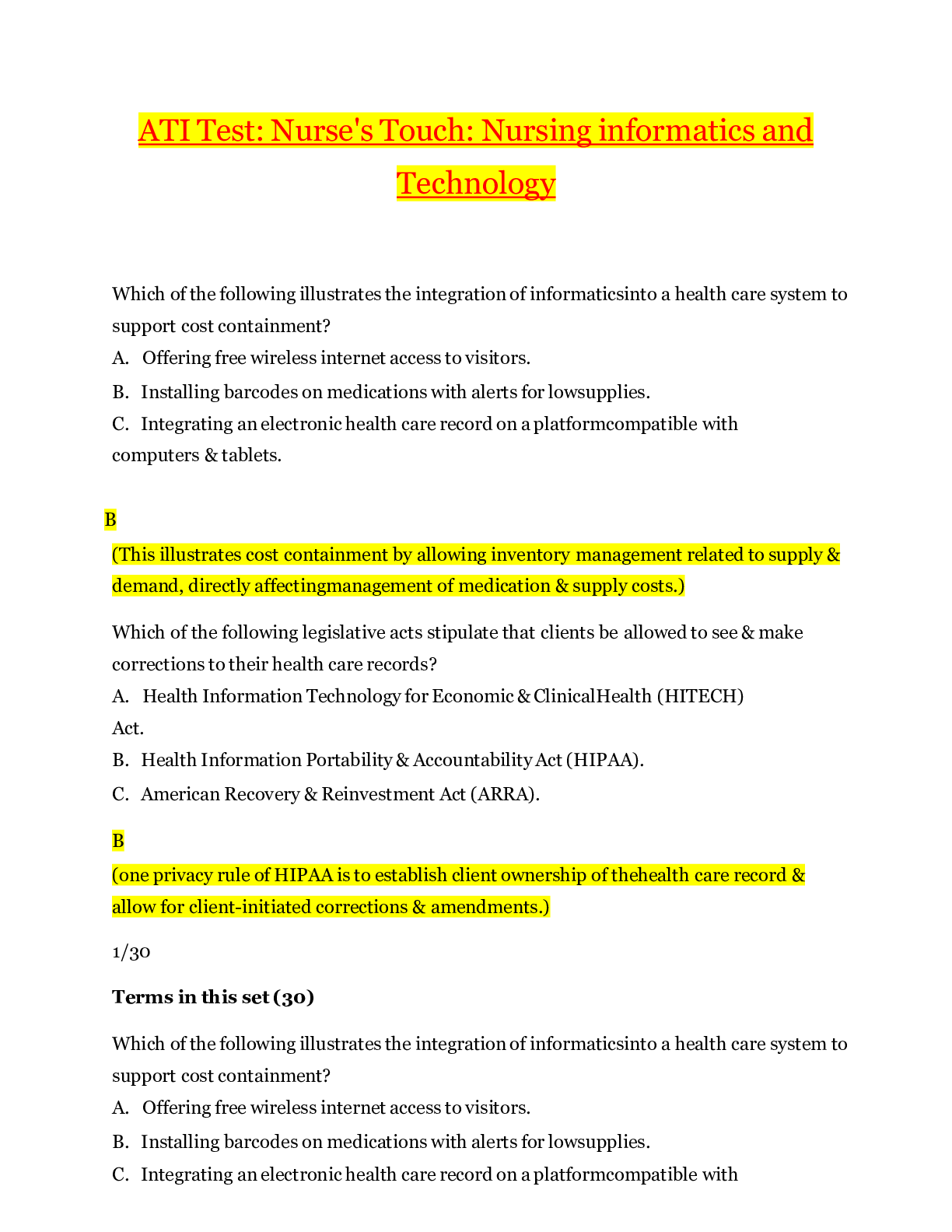
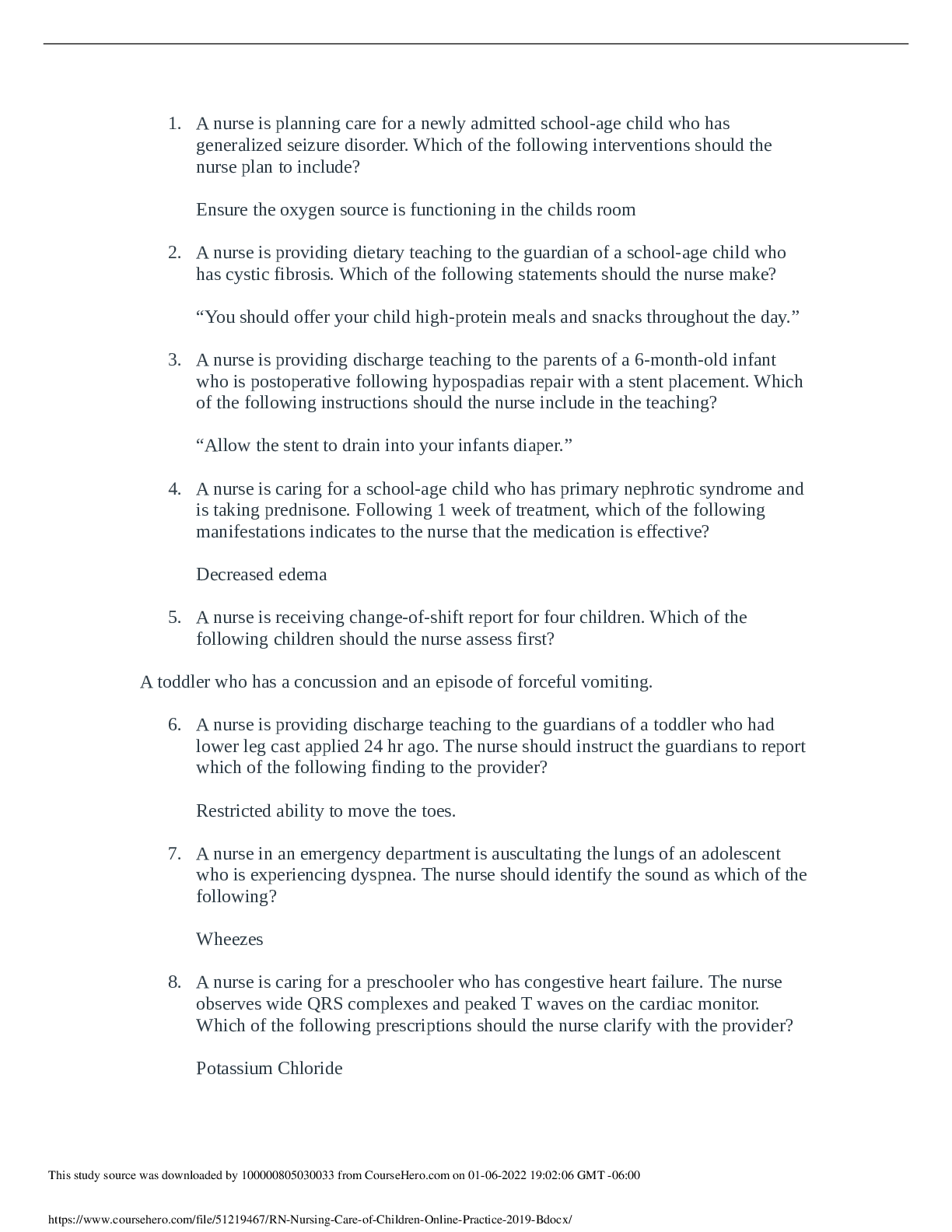
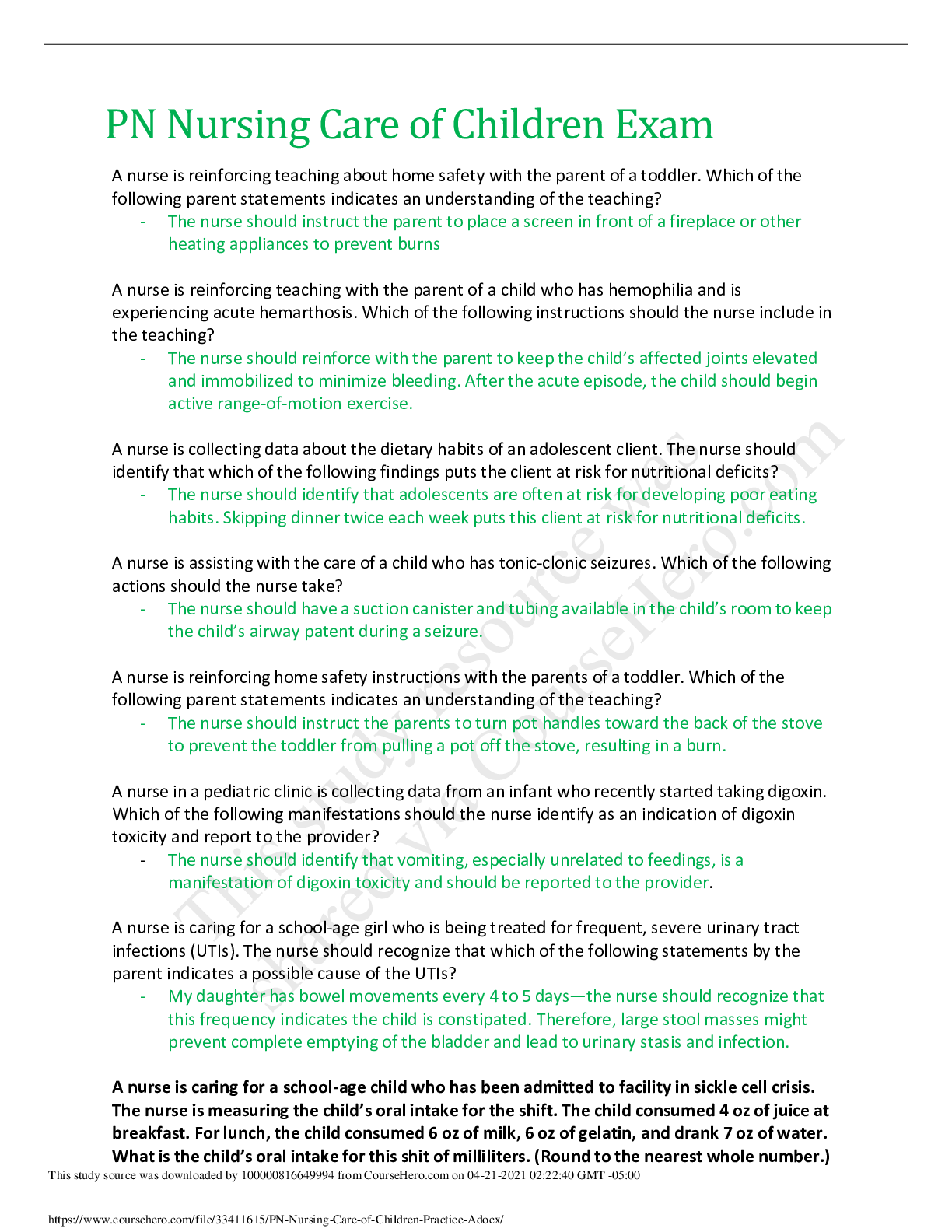


.png)
.png)
